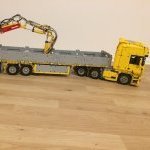Search the Community
Showing results for tags 'power functions'.
Found 368 results
-
.thumb.gif.ad7c8d88b264ee812194946c07404504.gif)
Power Functions V2 receiver not in new sets?
mocbuild101 posted a topic in LEGO Technic, Mindstorms, Model Team and Scale Modeling
While looking to buy a PF V2 receiver (58123bc01) I realized that it is only in 9398 and 41999 (both 4x4 crawlers), but is not in later sets like 42030 and 42065. I have been confused by this because I thought that it was suppose to replace the old receiver (58123c01). One thing I thought was that the insides were changed but they didn't have V2 printing, but why I don't know. Hopefully someone knows what's going on!- 43 replies
-
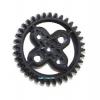
[MOC] Ariel Atom 500 V8
TheMindGarage posted a topic in LEGO Technic, Mindstorms, Model Team and Scale Modeling
This is my latest MOC: an Ariel Atom 500 in 1:9 scale! Technically it isn't a true scale model since I didn't use exact dimensions (I just build what I think looks best), but size-wise it's about 1:9. The real car is the fastest ever variant of the Ariel Atom, a street-legal car built for track racing. Released in 2008, the Atom 500 features a 3-litre transverse-mounted V8 made from two motorbike engines. It produces 500 horsepower (hence the name) and redlines at a rather insane 10,500 RPM. Other modifications include massive wings and the gold-painted exoskeleton. The car weighs only 550kg, giving it a power:weight ratio of over 900hp/tonne (higher than anything short of a Koenigsegg) - It recorded a 0-60mph time of just 2.3 seconds and could reach 200mph. It was the fastest road-legal car around the Top Gear Test Track for over two years. That record lap was on damp tarmac - had the track been dry, it would probably still be at the top. Only 25 of these cars were made, selling for around £200,000 each. My model features: Remote control drive and steering with Power Functions - 1 XL motor for drive and 1 M motor for steering 4-speed sequential gearbox operated with paddle-shifters Working steering wheel Full independent suspension with longitundinally-mounted shock absorbers Steering has zero scrub radius V8 engine replica with moving pistons The zero-scrub radius was a new idea for me. When playing around with suspension linkages, I discovered that mounting the links in a certain way would cause all four to move when turning (rather than just the steering link). The center of steering was further outwards, almost exactly in the middle of the wheels (I think it's where the suspension links would intersect when extended, but I'm not sure of this). The geometry I chose works almost perfectly for 68.8x36 ZR tyres on 56mm rims. Here's a picture of the steering links in their two extreme positions superimposed - the point where the wheel shafts intersect is the center of steering: The suspension is standard double-wishbone in the rear, but with a sideways lever converting the upwards motion of the suspension into longitudinal movement of the shock absorber: The transverse V8 was very difficult to fit in because it has even dimensions and the rest of the chassis has odd dimensions. It is connected directly to the XL motor The interior (or as close as you can get to an interior in an Atom) features two racing-style seats, a steering wheel and paddle shifters: The aesthetics were rather difficult at times. The framwork was very difficult even with the 42055 yellow parts (in fact, getting that set is the reason why I built this model), and at times I had to use some tricks. For example, the rear framework looks like it has two beams crossing in an X-formation when in fact the left and right halves of the "X" are two separate structures: I also replicated the exhaust pipes and gigantic rear wing. One of my favourite parts of the model is the side intake and its red stripe: The PF IR receiver is disguised as the air intake and roll hoop: For more pictures of the car, see my video below. Music is composed by me as well: [media]https://www.youtube.com/watch?v=RhmgbCIpHT0[/media] This project is also on LEGO Ideas! I know the success rate is extremely low for such projects, but it would be amazing if this set because a reality! Please support my project here. Any support is much appreciated.- 11 replies
-
- suspension
- rc
-
(and 5 more)
Tagged with:
-
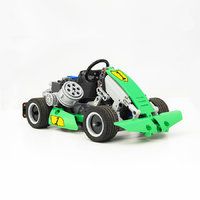
[MOC] Motorized Cherry Picker
Anto posted a topic in LEGO Technic, Mindstorms, Model Team and Scale Modeling
Hi! Two years ago, I did a motorizable cherry picker for a contest on the french forum TechLUG. So, I used the comments I had, and I decided to : - Use a more little scale - Better proportions - I did a better cab. In the first MOC, it was too heavy because of the battery box inside it. - The first cherry picker was motorizable by a M motor ; this one is only motorized, more simple and efficient. To summararise : Better proportions (I hope ^^) Only motorized I use inverted gearboxes for : - Outriggers - Arm - Turn table And the manual functions : - The steering (of course) - Extension of the arm So, here's the result: The simplest function is the steering. But there is the L motor over it. So, I used three 16t gears to turn the wheels directly by their axle of rotation. And now, the gearbox. It's an inverted gearbox : the "out gears" turn in the opposite sense. So, when you invert the position of the driving ring, you invert the rotation of a function. Here are screenshots: The outriggers can up the truck: the wheels don't touch the floor. To finish, the arm. It has a triple deformable quadrilateral. I needed so much time to do it, but it's nice to see in action. And the video :- 18 replies
-

Lego Tecgnic Truck 6x6 Off-Roader
nnamhcab posted a topic in LEGO Technic, Mindstorms, Model Team and Scale Modeling
A model I've been working for a little while, not much to show yet but pictures soon. 6x6 truck with locking rear diffs and 2 central diffs in the 6x6 drive making for a combination of power delivery choices, similar to the drive train of the mercedes amg 6x6. Using tires from 42054 so its, big near half a meter or so now. Rear live axel suspensions front independet fake v 10 soon to be geared in, possinble addition of 4 speed gearbox and 4 xl motors for drive. with fully rc gear and diff lock control and who knows what else? -
.thumb.jpg.050f28ccd893f68d8416233f594d9f3d.jpg)
LEGO Power Functions Electromagnet
shadow_elenter posted a topic in LEGO Technic, Mindstorms, Model Team and Scale Modeling
Hey builders! Recently I made a LEGO power functions laser (topic can be found here), and it got me thinking... what els can I build? That's how I came to the idea of making a LEGO electromagnet! Making it was actually a whole lot easier than making the LEGO laser. The LEGO laser required a 9 volt to 5 volt converter and reversed -polarity protection. The electromagnet was already made for 9 volt and it does not care about polarity. I just got the motor out and unhooked the 2 wires, then connected those 2 wires to the electromagnet and... it worked! I'm amazed by the strength of this small thing, under good conditions (unpainted, flat metal) it can lift up to 6 kilo's! I have no specific idea of how to use it in MOC but I'm sure I'll think of a good application for it. All suggestions are welcome by the way Tell me what you think ------------------------------------------------------------------------------------------------------------------------------------------------------------ BUILDING LOG weight: 78 gramscapacity: 6 kilo+ To make one yourself you need: PARTS: - a 9 volt electromagnet (ebay is a good source, I bought mine for 5.46$). - some glue (I used hot glue) - soldering tin & shrink tube TOOLS: - flathead screwdriver or prying tool - soldering iron -lighter (for shrink tube) First you need to open up the PF XL motor housing, this is quite hard. I found the best way is to squeeze it just a bit in a vice so the outer shell becomes oval and you can stick a small thin screwdriver in the gap to open it(mind the position in the vice!). This is what you will find on the inside: Disconnect the 2 wires attached to the motor, put the top half of the casing is a vice and dremel out the center rougly to the size of you electromagnet: Then make everything perfectly round with a small file untill the electromagnet fit's snug in the housing: After pressing it in the housing, get 2 lego beams and attach them to the 2 forward facing holes. this way you can make the magnet perfectly flush when mounted in a MOC: Then seal the electromagnet firmly in place using glue (I used hot glue). Next you solder the 2 wires coming from your electromagnet to the 2 wires that were attached to the motor (the inner 2 strands of the 4 strand LEGO wire, polarity does not matter). Make sure you use shrink tube to isolate both wires! Then glue the motor plate (holding the LEGO wire) in place and test the magnet! If it works close it up and you're done!! I hope you enjoined this build log, if you have any questions just let me know!- 11 replies
-
- electromagnet
- diy
-
(and 3 more)
Tagged with:
-
The Lost Tomb, is one of my latest creations. Our adventurer, Indiana Jones, descovers the lost tomb of the Islanders' King. I hope you like my creation, and I am open for your comments! Take a close look at the video that follows; by George Patelis, on Flickr The Lost Tomb is Revealed by George Patelis, on Flickr You can find more photos at my Flickr Account
- 10 replies
-

[TC11] La Grange 3001 (WIP)
teos posted a topic in LEGO Technic, Mindstorms, Model Team and Scale Modeling
I began to work on my 1st Technic moc yesterday to see what I could come up with. Here's my progress. I'm quite pleased with where I'm at and what I could accomplish, even if it is basic by many Technic builder standards. It drives nice on carpet, though I'd love to have those rubber dots to make it work on hard surfaces. 20170318_121559 by topazard, on Flickr 20170318_121636 by topazard, on Flickr 20170318_121659 by topazard, on Flickr Trying to figure out how to add a function will have to wait until next weekend (hopefully). By then I might have the parts to finish off the marbled top. For anyone wondering this is supposed to be a Grangemouth 3001.- 2 replies
-
- power functions
- technic
-
(and 1 more)
Tagged with:
-
Hello fellow builders! I felt that it was finally time to share with you all something that I've been working on/ playing with for a while now: My L-Motor Frame. L-Motor Block Types by Nick Jackson, on Flickr The concept for this project was to create a stable platform on which (primarily) steam engines could be produced with less motor& cable obstructions. L-Motor Block Types by Nick Jackson, on Flickr This would then allow the engine's body to be built relatively free of electrical components, or crammed with them in the case of tank engines. L-Motor Block Variants by Nick Jackson, on Flickr I think that the most interesting part of the frame is the fact that it is easily modifiable, and can essentially go from 2 to 7 axles! At the time of writing this however, I've only dared to go up to 4 axles for a related project. L-Motor Block Variants (2) by Nick Jackson, on Flickr Hopefully these frames and their different gear ratios will inspire you to make a steam engine! Although, there are a great many European engines that are not steam, but employ connecting rods for their drive wheels. L-Frame with Medium-Large wheels by Nick Jackson, on Flickr Lastly, here are some alternative wheel sizes that you may be interested in. These are made possible by the work of BigBen Bricks and @Shupp. The smallest feasible size would be the Medium-Large drivers by Shupp. These would need a bit of reworking from a standard L-Frame in order to clear switches and such. New Wheels!!! (2) by Nick Jackson, on Flickr Here, a set of XL wheels from BigBen fit nicely on a standard frame. L-Frame with XXL wheels by Nick Jackson, on Flickr And, by upgrading to the longer frame size, you could even accommodate 6 of Shupp's XXL wheels! Hopefully this post will benefit everyone, but moreso people who've had a difficult time getting into trains, and especially steam! Please, let me know your thoughts, and definitely share your ideas for a potential future build that might benefit from this design! Oh, and here's the link to the files: https://drive.google.com/open?id=0B9xAgBdzDImZaFFsM2lGVkdmcEk Thanks for reading, ~M_Slug357~
- 10 replies
-
- pf
- power functions
- (and 4 more)
-
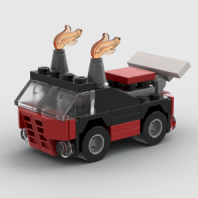
SlammerVan RC - 42030 C-Model
Immo posted a topic in LEGO Technic, Mindstorms, Model Team and Scale Modeling
Here's a little 42030 C-model (+ extra wheels, ONLY added extra parts). It was meant to be just a remedy for boredom while ill, so I build "just so", whatever comes to my mind - just wanted it to be remote controlled. But I quite like the result: a flamboyant van perfect for just cruising around and scaring people. It performs well enough for a heavy, single XL motor-powered model. The gearing somehow makes it slower on reverse which is a fringe benefit, realism-wise. Steering is quite good, turn radius is tight. 35 studs long body + 5 studs long "wings". Functions and feats: ► RC driving and steering ► sliding side doors on the right side, opening doors and fuel cap ► supercharger's scoop in the rear tilts up to reveal the gap leading towards the on/off switch that is activated by rod that can be kept on a special pivoted rack inside the van (you can use the "flag" poles as well, but that's just barbaric) ► non-functional decorated interior, including seats, steering wheel, gear shifter and handbrake ► details such as supercharger scoop, roof-mounted horns, floodlights and break lights, rear view mirrors, exhaust pipes, fenders, flags, radio antenna, floored interior- 7 replies
-
- rc
- power functions
-
(and 3 more)
Tagged with:
-
Greetings Train Tech, This MoC was actually built over a year ago! I originally designed and built it for use as a "demonstrator" model for a how-to post on Power Functions steam locomotives that I haven't gotten around to writing (although the precursor post is available). While we're waiting on that, I figured I might as well post this model. Prototype History British Railways built this class of 2-6-2 tank engines for a mixed traffic role. Apparently they were very similar to the LMS Ivatt Class 2 2-6-2T, from which they were derived. While none of the class survived into preservation, The Bluebell Railway is rebuilding one of the related 2-6-0 tender locomotives into an example of this class. Engineering Details Usually when I build a MoC, I start with the prototype in mind, then work towards the model. This model began with the desire to build "a small steam locomotive to demonstrate Power Functions", which then determined the choice of prototype. The Standard/Ivatt Class 2 has a number of helpful features in this regard: Small tank engine Large bunker could hide a Power Functions receiver Side tanks can cover up other Power Functions components And indeed, that's how the locomotive is laid out: Even so, the locomotive is quite cramped -- there wasn't enough room for an M-motor based transmission, so I went back to the trusty 9V gearmotor. The output shaft of the motor is very close to the driving axle: ... and it took me a couple tries before I found a good solution: The side tanks contain a channel that allows a cable to pass through, connecting the motor and receiver: The power button is on top of the smokebox and is only held in by gravity: Thank you for reading. Full Brickshelf gallery here.
- 6 replies
-
- moc
- steam locomotive
- (and 6 more)
-

Offline competition idea: Off the rails!
mahjqa posted a topic in LEGO Technic, Mindstorms, Model Team and Scale Modeling
Rules: Every vehicle is powered with a standard AA batterybox and a single medium motor. Length or width shouldn't exceed 16 studs. Prizes are awarded for prettyness, originality, best crash, and fastest speed. In that order. Prizes in this case were won by eti, lucrichters, koffiemoc, and trijntje, In that order. Adapt rules as needed. -
Lately I updated my CSX locomotives that I built back in 2014-2015. Since I perfected similar models with the Florida East Coast builds, I just took what I did and applied it to the models. Plus, I improved on where I placed my battery box making the engine much easier to operate! Here's video of me running it around my layout at Gold Coast Railroad Museum. I also threw in some model O Scale footage, perhaps for comparison Enjoy!
-
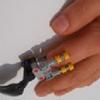
MOD 42062 container yard (only truck with trailer Fuly RC)
9 fingers posted a topic in LEGO Technic, Mindstorms, Model Team and Scale Modeling
Hello everyone. This is my modification of the truck vith container trailer. It is RC with power functions. 1 servo motor for steering 1 M motor for driving it is simply very cute to me and just fantastic to drive with this litle cute truck. and one simple video That's all for now. Best regards, Valter- 7 replies
-
- technic
- power functions
- (and 4 more)
-
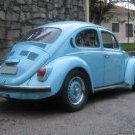
[MOC] WIP RADIAL ENGINE PLANE
omardib21 posted a topic in LEGO Technic, Mindstorms, Model Team and Scale Modeling
still working for 3 months into this moc, get some inspiration by the swith trick from the new 2017 blue tow truck, still lots things to do here, but each week i improove something, lets see where it will goes latest video: Thanks so much! Omar -

[MOD] Improved 42042 Crawler Crane
wmeredith posted a topic in LEGO Technic, Mindstorms, Model Team and Scale Modeling
Improved 42042 Crawler Crane. Banana Man for scale. It's hard for me to overstate how much I love the Technic Crawler Crane 42042. I've been constantly tinkering with it and making improvements since I got it about 6 months ago. My method is basically to lift heavier and heavier stuff until it falls over or something breaks. Then I rebuild. This is how it got to where you see it today. I don't really care about the tracks or the slewing. I want to lift heavier stuff, higher! So far my mod/improvement list reads like this: Upgraded the block & tackle harness for better mechanical advantage Added a quick-adjust system for efficient rigging changes to the harness, main hoist, and hook Beefed up gantry or A-frame: wider, taller, and much stronger Improved existing back hitch and added a second back hitch Counterweight box Strong, longer boom Paid almost (!)$20 for stupid Technic metal hook Integrated claw storage on gantry XL Motor upgrade Boom foot return damper thing Replaced LEGO string with synthetic cable (from Chin-a) Here it is in action. Read on for a more thorough description and photos of each mod/improvement. Click through on the photos to view them at larger sizes. Block & Tackle The first thing I did was add blocks to the block & tackle system allowing me to really turn up the mechanical advantage the motor has over the load when raising and lowering the boom. This of course comes at the cost of speed, but I'm OK with that. The nice thing about this is I don't have to actually use all the blocks. Quick Adjust Rigging on Harness and Main Hoist You can see my bright red and yellow-handled quick adjust axles with the red and yellow grips on the side of the harness assembly. This makes it easy to slip the rigging in and out of the blocks to fine tune my power/speed balance for the specific load. I also have these at the end of the boom and on the pulley so I can adjust the speed/power tradeoff on the hoist line. I added this quick disconnect system after I'd re-strung the rigging for the hundredth time. I can re-thread the rigging on both the harness and the main hoist line to go from "high gear" with max lift speed to "low gear" for max power in just a minute or two. (I had originally made these with axles that have stoppers on the end, but ended up using regular axles, because I have a ton of them.) A couple of timelapse (YouTube) videos of the quick change. Stronger & Wider Gantry The gantry in the stock model is really weak. It is wholly comprised of 4 Technic lift arms held in place with 6 friction pins. As I added heavier loads this system was quickly outgrown. I was bending lift arms and even popping the entire assembly off the superstructure. So I rebuilt. The new gantry is wider, allowing for more blocks in the harness. It is many times over more rigid and is taller, allowing the harness mount to be further back over the body, which in turn allows the main boom to be drawn up higher to a much steeper final angle. This piece took a long time and has been through the most revisions over the months. I did a lot of research by looking at other LEGO models, other and peoples crane MOCs. Both arms of this gantry are heavily inspired by the gantry on LEGO Crawler Crane 8288 (http://brickset.com/sets/8288-1), which I would love to own a copy of someday (not today). Improved Back Hitch The back hitch (the two black lift arms supporting the gantry) also quickly became insufficient. The anchor it was tied into was bending and getting stress cracks, so I created a stronger attachment system for it elsewhere. I also added a second back hitch that ties directly into the improved counterweight... Counterweight Box One of the challenges with cranes is counterweight. As the amount of load it can lift and move improves, their is a corresponding increase in risk of tipping. The original model cleverly uses the battery box mounted all the way at the back edge of the body. It's literally the furthest element from the tip of the boom. I added a weight box behind it that is open and easily filled with ballast of my choosing. C Batteries work extremely well because of their density and modularity. It has an open design so it's easy to adjust the weight on the fly as needed depending on the load and the angle of the boom. After building it, I added a the second back hitch directly attached to the gantry to remove stress from the body connection of the weight box and from the first front back hitch (heh). When the gantry starts carrying a lot of load, I don't know that the front hitch bears any at all. Stronger, Longer, Better Boom Maybe the most noticeable feature is the length of the new boom. The original is 30 studs long, not counting the butt and tip, with an optional section to extend it to 45 studs. This booms main section is 75 studs long. At this length, it had some really concerning droop/bending at full extension. However, I was also able to easily reconfigure the inner supporting structure to be much stronger since I didn't care about the ability to easily add and remove sections. I also added the outer white panels to help with rigidity as they span the weak links between the blue 15L lift arms that are the main defining component of the boom. The boom tip received an upgrade in the form of a smoother operating block and tackle system (with quick disconnect axle just like the harness) controlling the main hoist. I also added an aviation warning light, obviously the most complex and impressive mod thus far :) Main Hook/Claw Storage I purchased a Technic Large Metal Hook (http://www.bricklink.com/v2/catalog/catalogitem.page?P=70644#T=P) for like $15. It's easily the most I've ever paid for a single LEGO piece. Considering the time I've spent on this model, though, I thought it was worth it. It's mounted to the main hoist with the smallest of my quick adjust rigging axles. I can attach the hook directly to something of course, or I can use it to hang the functional claw the system came with. When the claw is not in use, I have a storage peg for it that can be placed on either side of the gantry. I built this after I got tired of it sitting on the bench next to the crane most of the time. Much like the quick adjust rigging system, it's a simple mod that has a high convenience impact when moving this thing around for play, improvements, and storage. More Power (XL Motor upgrade) After removing the clutch gears and incrementally strengthening everything else to lift progressively heavier and heavier loads through probably hundreds of lifts at this point, the 9V Power Functions L Motor (99499) that came with the system finally died (predictably). To LEGO's credit, they're already shipping me another. They didn't even ask if it had been systematically subjected to increasing levels of abuse since purchase. Rather than wait for the replacement to arrive I hooked up an XL I had laying around. It's slower, but has more torque. As you can see it is mounted almost all the way at the front of the body, which is not ideal considering the weight. I may end up routing it further back if I can figure out a way to that looks this good. I did have to git rid of the ladder that was here on the original model, but this is Technic, so whatever. It's not like I'm bouncing minifigs around and doing voices when I play with the thing. Boom Return Damper/Helper If you increase the mechanical advantage of the harness too much, the boom has trouble releasing from very high angles. There just isn't enough weight to pull the cable off the spool on the base. I added this spring mechanism to the butt of the boom to help push it out when there is very little lateral load. I may be swapping these gray Technic springs out soon for the stronger yellow ones as it could be more effective. They will also look better matching the contrasting yellow parts of this assembly against the blue. Rigging Cable Through many rounds of adjusting and rebuilding I replaced the rigging cable several times. As I added to the superstructure more cable length was needed. Going down certain oaths and backtracking also had me replacing the cable with different lengths over and over. LEGO string is expensive, so I ended up buying a small spool of this stuff off Amazon: https://www.amazon.com/gp/product/B00LDIKURQ/ref=oh_aui_search_detailpage?ie=UTF8&psc=1 after seeing it recommended elsewhere on these boards. It works well. It's thicker than LEGO string, so be aware, but it's also stronger and it has a bit of a metallic shine, so it looks more like the steel cable you'd see on the real life inspiration for this model. Conclusion That's about it. The major takeaway is that this thing can now lift 750 grams up off the floor below my bench and place it on the bench right next to it (from up to 80 cm away). Good stuff. I also think I retained most of the good looks of the original set. I'm not done tweaking yet, but I wanted to do this write up and show it off a bit before I break it again, because my next mod is likely going to happen in the gear box, if at all.- 7 replies
-
- 42042
- crawler crane
-
(and 2 more)
Tagged with:
-

[MOD] RC Mini Buggy
Like a Rolling Brick posted a topic in LEGO Technic, Mindstorms, Model Team and Scale Modeling
Hi guys! This is my version of pg5200's Mini Buggy. I used the same chassis of the original one adding some minor changes to the bodywork, to make it more "pimped out". The front bullbar is the same of another model that is strictly related to this one, DesignJunkie58's Small RC Buggy. The model is run by a RC Motor with Servo for steering, both fueled by an AAA Battery Box. The IR Receiver is v2. I also tried a 1:1 gears ratio as shown in Piterx' Gearsbraker Sandrail, but the RC motor had the tendency to overheat. Anyway the problem doesn't happen with the 1:1.667 ratio. The buggy is small and very fun to play outside on a moderately dirty road. As I usually drive in my apartment, I put at the back the Old School 20x30 tyres, the rubber of which is harder and smoother. This way, when the RC motor runs fast and you steer, the back end gets loose on the floor and the model suddenly drifts...- 11 replies
-
- rc motor
- buggy motor
-
(and 1 more)
Tagged with:
-
Hallo everybody, after reading all the time in this forum I want to introduce my not in all details finished Scania R730 6x2. For driving the Scania uses the Lego xl-motor. For steering the first and second achses I use the servo-motor. For the movement of the pistons in the fake v8-engine the Scania uses a l-motor. For all I use a rc! The batteriebox is in the back of the cabin, which I can lift. In the back of the Scania I installed an automatically closing clutch for trailer. Steffen
- 15 replies
-
- power functions
- rc
-
(and 1 more)
Tagged with:
-

Fragile wires or not
jorgeopesi posted a topic in LEGO Technic, Mindstorms, Model Team and Scale Modeling
Lately I have broken down 3 standar motors, all because of the wires, all my MOCs are very small and the place for cables is always low. How often do you break the cables?, I think that my case is normal, 4 standar motors and 1 XL broken in 7 or 8 years always using the same motors MOC after MOC It's understandable.- 20 replies
-
Hi, This building is stuffed with power functions and lights, so please take a look at more pictures and movies on my flickr. Short movie: see here. More detailed shots (but poorer quality - I have some problems with camera): see here. I was inspired by special kind of nativity scenes called "Kraków szopka" (see here). However final result looks rather like "Gasthaus". I should mention that all elements are powered by one Lego motor. And they could be driven manually by one crank. And this is my first creation where Lego Technic parts (gears etc.) are doing their proper work (they are not used just for decorations).
- 14 replies
-
- power functions
- christmas
-
(and 5 more)
Tagged with:
-

PF Polarity Switch Differences
BrickWild posted a topic in LEGO Technic, Mindstorms, Model Team and Scale Modeling
Brickshelf user "lukasz7792" has just posted an interesting comparison picture of an older & newer PF Polarity Switch. The one on the left has a black reversing switch and the one on the right does not. Does anyone know why it was omitted?- 5 replies
-
- power functions
- pf
-
(and 3 more)
Tagged with:
-

[MOC] Canadian National X-10-a with Power Functions and 9v
Commander Wolf posted a topic in LEGO Train Tech
Well, it's been more than a year since I started work on my last locomotive MOC, the China Railways QJ. Having built most of the practical engines (not too big for R40 curves) that I was visually interested in, I had to wait a bit before my interest was piqued again on the locomotive front. My inspiration came from running the QJ at most BayLUG meetings for the past year and change. The QJ isn't necessarily unreliable or difficult to set up, but it's still not very convenient: the model isn't that easy to move around or manipulate due to the size, the tender, and the number of fragile bits. The lengthy drivetrain with its fair amount of friction and torque also prevents the engine from generating smooth low-end torque. Finally, BayLUG still runs 9v at most of our shows, and the QJ can't easily be converted to run on 9v. So this is really my second locomotive to be born of functional requirements (the first was my U30B): 1. It should be easy to transport [from here to there] and move around [a layout] 2. It should be designed with robustness as a key feature 3. It should be easily convertible between PF and 9v operation 3b. The PF components should be easily removable (also helps with charging) 3a. It should run smoothly when pushed [by a 9v power car] Requirements 1 and 3 really insist that this engine be a large tank engine: for 1 I don't need to deal with a tender when transporting or moving and for 3 it needs to be big enough to fit all of the PF stuff. It actually took me quite a bit of time to zero in on the X-10-a as large tank engines are apparently pretty rare in the US and North America: it seems that even most of our branch line and shunting steam engines were tendered. But eventually I found a drawing and the work began! What I learned from the QJ is that if the weight of the loco is properly distributed, one powered (and tyred) axle is good enough to generate usable torque. From this notion I designed the chassis to have exactly that one powered axle, which I could easily remove to remove tyres and gearing for 9v operation. For the same reason, the driven axle isn't cranked either; in the QJ I would have had to remove all of the cranks and all of the wheels to access the tyres or gears. The lack of cranks on the driven axle also lets me keep the chassis articulated, which should help minimize rolling resistance for 9v operation (say compared to a 6-coupled flange-blind-flange configuration for the drivers). The drive rods are made using the half-pin in rod-track technique, and there's a bit of a hack: the connecting rods have to go around a corner due to the articulation, so the travel is longer than the usual three studs, and the connecting rods are both loosely pinned down and made of flex. As far as I can tell this arrangement doesn't add significant friction, probably because the corner is very small. The engine is designed to be powered with two M-motors, but I'm using the E-motor right now for the novelty. Unfortunately it wasn't quite possible to get as much weight as I would have liked over the driven axle: the battery box must go behind the boiler due to its height, and that really limits weight distribution options. The loose 9v motor in the front is simulating the weight of a second M-motor, and it helps bring the net weight over the driven axle to maybe 60 percent? Here you can also see how all the bits come out of the engine: almost all of the top surfaces are detachable. Whether this is convenient enough to fulfill requirement 3 remains to be seen. Construction of the body is actually very similar to that of the QJ: structural integrity is mainly provided by studs-out beams and everything else is studs up. Stickers are created at 300DPI and printed on 3M 3200-L mailing label material. This is a small detail, but it is actually one of my favorite parts, inspired by and stolen from 60052: And finally a video showing the locomotive running. The first 70 seconds is PF running and the last 20 seconds is 9v running. For PF running I'm using the AAA battery box with AAA Eneloops and the aforementioned E-motor. The E-motor is actually pretty neat: it has a wider dynamic range than the other PF motors and it is quite quiet as well. Sadly it is a little bit underpowered as well; I'm geared down 3:5 and you can still see it struggle a little in the corners during the PF segment. The 9v segment is a bit hazy, but we ran out of sunlight because DST. The engine is actually smoother than I would have guessed in the unpowered configuration: you can see how it basically doesn't lose *any* speed in the turns, and the regulator is only turned up to notch 3. Alright, I think that's all the commentary I have on this. There is as usual a full gallery if it ever gets moderated. There's a bunch of build and reference pics there that I didn't show. EDIT: Instructions for this model are now for sale on Rebrickable: https://rebrickable.com/mocs/MOC-61355/NonsenseWars/148-canadian-national-x-10-a-powered-up- 10 replies
-

5571 Black Cat + Power Functions
der seb posted a topic in LEGO Technic, Mindstorms, Model Team and Scale Modeling
Hi, a few months ago, I fulfilled a childhood's dream and bought the awesome set 5571 - Black Cat! I built it, looked at it and was happy. But then I got the Volvo L350F and was fascinated by the RC possibilities. I wondered if this would be possible with the Black Cat as well. I did a quick research but did not found someone who built it yet. So I definately HAD to do it The truck itself is very big, so there would be enough space for all components. A big hood, large free spaces in the chassis, ... But I wanted to integrate all Power Functions WITHOUT notice from outside. So there should be no modifications to the driver cabin or the Lego-built motor. The PF-Reciever needs visual contact. I don't like that and I couldn't find a suitable space where the reciever could fit as well. Therefore I switched to SBrick, which also workes burried deep inside the truck. All PF: 1 Servo 1 XL-Motor 1 battery box 1 SBrick 1 PF extension cable After a lot of trial and error I finally fit all PF inside the chasis! The servo sits directly on the steering. The full lock is a bit higher than on the original, so I had to remove the blue tiles. The XL-motor is located vertically beneath the bed. So between servo and XL there is a gap of less than 9 bricks which just enough for battery box and all cables. The SBrick sits on the battery box's top (1 plate beneath the truck's seats). It's ultra tight but works! I also added twin wheels on both rear axles. Have a look at the video here: A look inside: And the complete set on Flickr - Sebastian-
- 5571
- power functions
-
(and 1 more)
Tagged with:
-

MOC - my moc collection
omardib21 posted a topic in LEGO Technic, Mindstorms, Model Team and Scale Modeling
hello, made a lil video showing a minifig next my models to compare scale, this weekend i will make a good video and share here my submarine, thanks! -
Dear Lego Fans, While at work, my colleges and I were talking about how awesome it would be to connect our work desks with a cargo train to haul post-it notes, candy and office utilities around our office. I offered to bring my old Lego train set and we set it up during our lunch break. It has really relighted my love for Lego trains! I got my first Lego set around 1999/2000 with the blue and white Lego Railway Express (Set 4561). Being a kid at that time, I could not afford much Lego. I got a few track-packs and switches and intersections. I also bought a Santa Fe engine and one of the cars with it. I've stopped playing with lego all together roundabout 2006/2007 when the first RC train sets were released and 9V systems were retired. It's been 10 years since I last got my train set out and now being an adult with money on my hands, I really feel like getting back into the Lego trains that I so dearly loved as a child. I'm now faced with a few problems since the 9V system is no longer available. For one I know very little to nothing about the new train sets. I'm wondering wether it's worth buying a new train set or not, which train set to get, or just lurk around eBay to see if someone might want to sell their old 9V system. I'm thinking of building a new, larger layout in my basement once I bring home my train set from the office. As far as I know, all the rolling stock will work fine on the new rails and the new trains run fine on the 9V track. so to conclude, here's a list of questions I have: - Are there any train sets out right now that I should get? - Are there any train sets coming out in the near future that are worth waiting for? - Should I not care about the new train systems at all and check eBay frequently for old 9V sets? If anyone is interested, I will post some pictures of our little office-cargo-train thank you in advance!
- 16 replies
-

[MOC] (finished) Iron Duke radial technic plane
omardib21 posted a topic in LEGO Technic, Mindstorms, Model Team and Scale Modeling
hello, im selling all my legos, need some money so i will keep my mocs, so i builded a huge one, to use all parts that could be nice to put in use into a future moc its a pre ww2 based plane, i already put the wip step into another topic, here i will put the final version, if you guys have ideas to improve, you all are welcome! Video: Pics: PB214220 by Omar Dib, no Flickr PB224235 by Omar Dib, no Flickr PB224237 by Omar Dib, no Flickr PB224226 by Omar Dib, no Flickr PB224227 by Omar Dib, no Flickr PB224228 by Omar Dib, no Flickr PB224229 by Omar Dib, no Flickr PB224230 by Omar Dib, no Flickr PB224231 by Omar Dib, no Flickr PB224232 by Omar Dib, no Flickr PB224233 by Omar Dib, no Flickr





